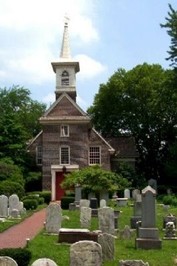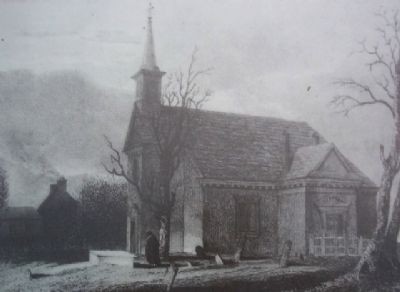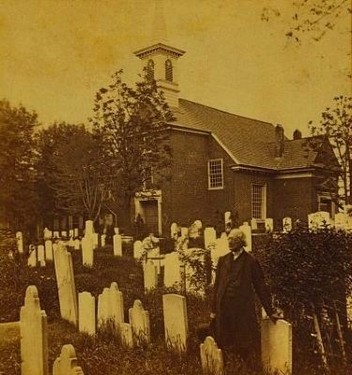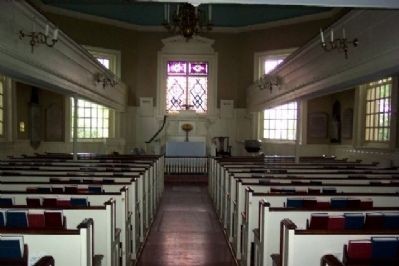Gloria Dei Church (Old Swedes' Church)
Introduction
Text-to-speech Audio
Images
Gloria Dei / Old Swedes' Church and Burial Ground (image from Historic Markers Database)

1825 engraving by C.G. Childs, depicting Old Swedes' Church (image from the Historical Society of Pennsylvania)

Reverend Clay in the Old Swedes' Churchyard c. 1860 (image from the Library of Congress)

Interior of Old Swedes' Church (image from Historic Markers Database)

Backstory and Context
Text-to-speech Audio
The colony of New Sweden was officially established in 1643 and the first church in the area, built in 1646, was built in its capitol, New Gothenburg, along the Delaware River; the establishment would later move to the village of Wicaco (present-day Queen Village), on land donated by the Sven family. Their one and a half story log house stood at the northwest corner of present-day Beck and Swanson Streets, encircled by a large garden and fruit trees and with its own dock for small boats. (The house was destroyed during the American Revolution, when the British Army used its logs as fuel.) The Sven blockhouse, dating to 1666, was used as a place of worship beginning in 1677.
When New Sweden came under British rule, William Penn established the city of Philadelphia in 1682, at the time just north of the Swedish village at Wicaco, which Penn renamed Southwark, after a London neighborhood along the Thames River. As a Quaker, Penn ensured religious tolerance, and the Swedes, who had established six congregations by that time, decided to construct their first permanent church, Gloria Dei, in 1698. Under the supervision of Pastor Andreas Rudman, the church was completed and dedicated on July 2, 1700. Originally, the church was a 30 by 60 foot rectangle, with a tower added in 1703 and a sacristy and vestibule added to the north and south sides in 1704. The last two were added in order to buttress the walls, which had begun to bow in spite of their thickness. Considered Vernacular in style, Gloria Dei Church blended elements of medieval, Gothic, Georgian, and Scandinavian influences, and was built primarily by Philadelphian craftsmen of English origin. Its bell, the same bell used at New Gothenburg in 1763, was recast and enlarged in 1806 to improve its sound. The bell's inscription reads, "I to the living call, and to the grave do summon all." A churchyard was established the same year as the church itself, in continuous use since the early 1700s and one of the oldest graveyards in Philadelphia. Burials include Scottish ornithologist Alexander Wilson, Revolutionary and Civil War soldiers, sea captains, artist and soldier James Peale, Brigadier General and United States Congressman General William Irvine, and several ministers.
Gloria Dei's first pastor, Andreas Rudman, suffered from ill health and was replaced by Anders Sandel in 1702. Rudman went on to a Dutch Lutheran church in New York City, then returned to the Philadelphia area as pastor of two Church of England congregations. Along with Pastors Sandel and Bjork, Rudman also officiated at the first ordination in the Middle Atlantic, that of Justus Falckner in 1703. For the ceremony, an organ was played at the Gloria Dei for the first time--and the first time any American church had used an organ. Falckner replaced Rudman in his New York pastorship, and when Rudman died on September 17, 1708 at the age of 40, he was buried in Gloria Dei Church. Anders Sandel visited Swedes living in Kinsessing and Upper Merion, creating annex churches of the Gloria Dei congregation. The next pastor, Jonas Lidman, served from 1719-1730, after which the church struggled to compete with other denominations in the Philadelphia area. From 1733-1737, the church was without a pastor, until Johan Dylander rebuilt the congregation. Upon his death in 1741, Dylander was buried in the church alongside Rudman. When Moravion missionaries converted more of the congregation away, Pastor Gabriel Nasman considered working with the German Lutherans in the area. But it was Carl Magnus Wrangel, during his pastorship from 1759-1768, whose ties to the political and intellectual elite of Philadelphia and other Swedish missionaries from Wilmington and Swedesboro, who managed to restore the congregation.
Nils Collin became the last Swedish pastor of Gloria Dei beginning in 1784. He had come to the area in 1770 and was a close friend of Benjamin Franklin. Though he claimed exclusive loyalty to the King of Sweden throughout the American Revolution, both the English and the Revolutionaries accused him of collaborating with the enemy. Though Collins' diary and letters survived and are held in the Gloria Dei archives, church records from the Revolution are missing. Swedish missionary efforts ended in 1787, and Nils Collin was elected by his congregation to remain pastor, with the blessing of the Bishop of Uppsala. Collin died at age 87 in 1831, and was buried under the floor of the church.
Collin was succeeded by Jehu Curtis Clay, under whose pastorship the sexton's house and rectory were built in the 1830s. Gloria Dei became part of the Episcopal Church in 1845, as did its former annex churches at Kingsessing and Upper Merion. By this time, the congregation had outgrown the church building, but instead of relocating, it was decided that the church would be renovated. The floor was raised, central heating was installed, and balconies were added in 1846, as well as the building's only stained glass window, the earliest of its kind in America. In 1863, a parish hall and school were added. After Clay's death, Snyder Binns Simes became pastor in 1868, serving until 1915. The organ which still stands in Gloria Dei Church, a 1,300-pipe Hook and Hastings, was installed in 1903 and renovated in 1992. In 1917, the church opened a museum dedicated to its history.
From 1933-1972, John Craig Roak was pastor at Gloria Dei. He and his wife, Marian, took an interest in the Swedish history of the church, establishing a Swedish traditional Luciafest celebration beginning in 1938. Models of the Kalmar Nyckel and the Fogel Gryp, the first two ships to bring Swedish settlers to America, were presented to the church in the same year. Through Roak's efforts, Gloria Dei received National Historic Site status in 1942, allowing restoration of the surrounding block to appropriately historical standards and landscaping thanks to a National Park Service land grant. Roak House was constructed in 1969, and David Buchanan Rivers took over the pastorship in 1972. Hilmer Lundbeck established an endowment fund for Gloria Dei Church preservation, and with additional funds from the William Penn Foundation in 1999 and other donors, a restoration was completed on the interior and most of the exterior of the building.
Historic Marker Inscriptions:
Gloria Dei (Old Swedes' Church)
Oldest church in Philadelphia. Founded, 1677, by Swedish settlers. This edifice of Swedish architectural design, was erected 1698-1703. The earlier place of worship was a blockhouse. / “I joined in marriage the first couple, viz., Jonas Jonson, a Swede, and Anne Amesby, an English woman, in the English language.” Diary of Rev. Andreas Sandel, July 29, 1702 / Here are the memories of an all but forgotten group of early settlers in America - the Swedes. More than 300 years ago, before the founding of the city of Philadelphia, Swedes settled the Delaware Valley. Religion was important to these early pioneers who first worshipped in log buildings in 1677. / The present church was dedicated in 1700, and is now the oldest church in Pennsylvania. Later, English immigrants founded Philadelphia, resulting in the eventual assimilation of the Swedes. / Today the Episcopal congregation of Gloria Dei Church helps to preserve the pioneering heritage of the Swedes who settled here when this was only wilderness. / Gloria Dei (Old Swedes') Church was designated a National Historic Site in 1938. Park-owned land surrounding the church helps to preserve the historic setting. The church buildings and burial ground are privately owned and administered. Visitors who enter with respect are welcome during scheduled hours.
1708
Rev. Rudman Burial Marker (Inside Church)
This marble covers the remains of the Rev'rend Andrew
Rudman: being sent hither from Sweden. He first founded & built this
church. Was a constant, faithful preacher in th' English, Swedes & Dutch
churches eleven years in this countrey: where he advanc'd true piety, by sound
doctrine & good example. He died Sepr. 17, 1708. Aged 40 years.
